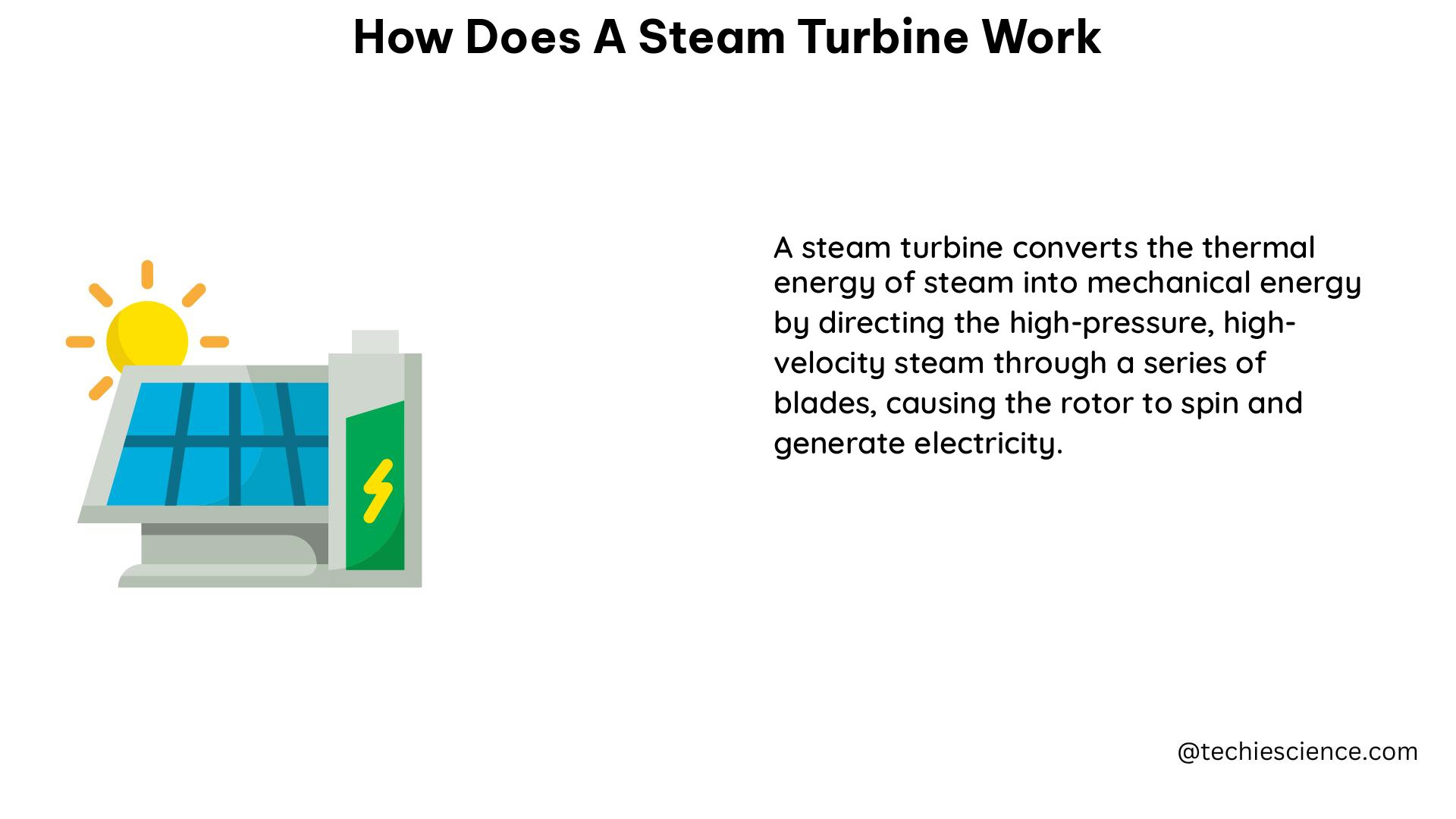A steam turbine is a complex machine that converts the heat energy of steam into mechanical energy, which can then be used to generate electricity or provide mechanical power for various industrial applications. The working principle of a steam turbine involves the expansion of high-pressure steam, driving a series of rotating blades and causing the turbine shaft to rotate, thereby producing mechanical energy.
Understanding the Key Components of a Steam Turbine
-
Steam Inlet: The steam turbine’s operation begins with the introduction of high-pressure, high-temperature steam into the turbine. The steam pressure can range from a few pounds per square inch (psi) to several thousand psi, depending on the application, with higher pressures resulting in greater turbine output and efficiency.
-
Rotating Blades: The high-pressure steam enters the turbine and flows over a series of rotating blades, causing them to spin. The velocity of these rotating blades can exceed 1,000 feet per second, with the blade velocity determined by the steam pressure, temperature, and the size of the turbine.
-
Turbine Stages: A steam turbine typically consists of multiple stages, each with its own set of rotating and stationary blades. The number of stages can range from a few to several dozen, depending on the size and application of the turbine. As the steam passes through each stage, it expands and loses pressure, driving the rotating blades and producing mechanical energy.
-
Turbine Shaft: The rotating blades are connected to a central shaft, which converts the mechanical energy generated by the spinning blades into rotational motion. The speed of the turbine shaft can range from a few revolutions per minute (rpm) to several thousand rpm, depending on the application.
-
Turbine Output: The output of a steam turbine can range from a few kilowatts to several hundred megawatts, depending on the size and application of the turbine. The efficiency of a steam turbine can range from 20% to 40%, with higher efficiency resulting in greater electrical power output and lower fuel consumption.
-
Steam Consumption: The amount of steam consumed by a steam turbine can range from a few pounds per hour to several thousand tons per hour, depending on the size and application of the turbine. This steam consumption is a critical factor in the overall efficiency and cost-effectiveness of the steam turbine system.
-
Turbine Inertia: The inertia of a steam turbine is determined by the mass and size of the rotating components, such as the blades and shaft. High inertia results in greater stability and slower response times, while low inertia results in faster response times and greater susceptibility to instability.
Factors Affecting Steam Turbine Performance

-
Steam Pressure: The pressure of the steam entering the turbine is a crucial factor in determining the turbine’s output and efficiency. Higher steam pressure results in greater turbine output and efficiency, as the steam can expand more and do more work on the rotating blades.
-
Steam Temperature: The temperature of the steam entering the turbine also plays a significant role in the turbine’s performance. Higher steam temperatures, typically ranging from a few hundred degrees Fahrenheit to over 1,000 degrees Fahrenheit, result in greater turbine output and efficiency.
-
Turbine Design: The design of the turbine, including the number of stages, the shape and size of the blades, and the overall configuration of the turbine, can significantly impact its performance. Optimizing the turbine design is essential for maximizing efficiency and output.
-
Maintenance and Condition: Proper maintenance and monitoring of the steam turbine’s condition are crucial for maintaining its performance over time. Factors such as blade wear, bearing wear, and other mechanical issues can impact the turbine’s efficiency and output.
-
Operating Conditions: The operating conditions of the steam turbine, such as the load on the turbine, the ambient temperature, and the availability of cooling water, can also affect its performance. Optimizing the operating conditions can help maximize the turbine’s efficiency and output.
Practical Applications of Steam Turbines
Steam turbines are widely used in various industries, including power generation, manufacturing, and transportation. Some common applications of steam turbines include:
-
Electricity Generation: Steam turbines are the primary drivers for electricity generation in thermal power plants, where the heat energy from the combustion of fossil fuels or nuclear reactions is used to generate steam, which then drives the turbine to produce electricity.
-
Industrial Process Heat: Steam turbines are used in industrial settings to provide mechanical power for various processes, such as driving compressors, pumps, and other machinery. The exhaust steam from the turbine can also be used for process heat, improving the overall efficiency of the system.
-
Marine Propulsion: Steam turbines are used in some marine applications, such as in large ships and aircraft carriers, to provide the mechanical power for propulsion.
-
Cogeneration: Steam turbines can be used in cogeneration systems, where the exhaust steam from the turbine is used for both electricity generation and process heat, improving the overall efficiency of the system.
Conclusion
In conclusion, a steam turbine is a complex and highly efficient machine that converts the heat energy of steam into mechanical energy, which can then be used for a variety of applications. Understanding the key components, factors affecting performance, and practical applications of steam turbines is essential for engineers, technicians, and industry professionals working with these systems.
References:
- https://petrotechinc.com/how-does-a-steam-turbine-work/
- https://www.geovernova.com/content/dam/gepower-new/global/en_US/downloads/gas-new-site/resources/reference/ger-4190-steam-turbine-thermal-evaluation-assessment.pdf
- https://alliedpg.com/latest-articles/steam-turbine-work/
- https://www.power-eng.com/steam/how-does-a-steam-turbine-work/
- https://www.siemens-energy.com/global/en/offerings/power-generation/steam-turbines.html

The lambdageeks.com Core SME Team is a group of experienced subject matter experts from diverse scientific and technical fields including Physics, Chemistry, Technology,Electronics & Electrical Engineering, Automotive, Mechanical Engineering. Our team collaborates to create high-quality, well-researched articles on a wide range of science and technology topics for the lambdageeks.com website.
All Our Senior SME are having more than 7 Years of experience in the respective fields . They are either Working Industry Professionals or assocaited With different Universities. Refer Our Authors Page to get to know About our Core SMEs.